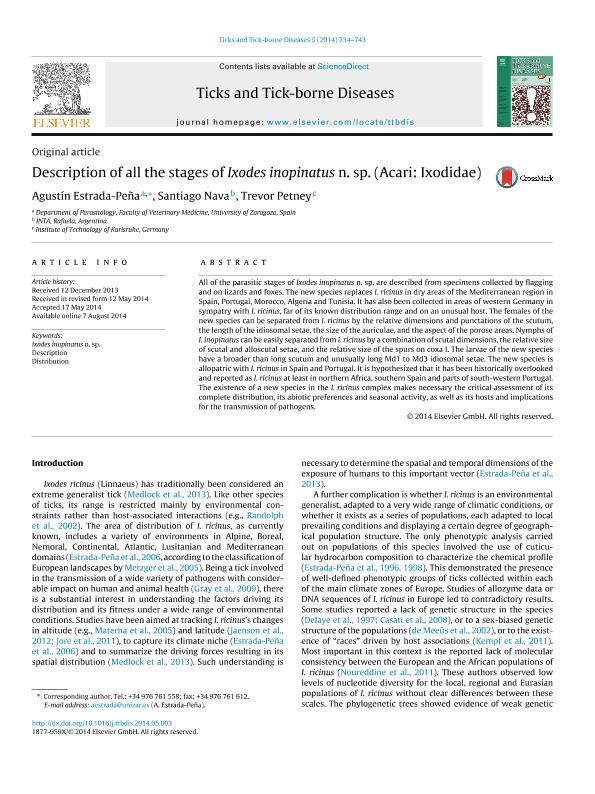Artículo
Description of all the stages of Ixodes inopinatus n. sp. (Acari: Ixodidae)
Fecha de publicación:
08/2014
Editorial:
Elsevier Gmbh
Revista:
Ticks and Tick-borne Diseases
ISSN:
1877-959X
Idioma:
Inglés
Tipo de recurso:
Artículo publicado
Clasificación temática:
Resumen
All of the parasitic stages of Ixodes inopinatus n. sp. are described from specimens collected by flagging and on lizards and foxes. The new species replaces I. ricinus in dry areas of the Mediterranean region in Spain, Portugal, Morocco, Algeria and Tunisia. It has also been collected in areas of western Germany in sympatry with I. ricinus, far of its known distribution range and on an unusual host. The females of the new species can be separated from I. ricinus by the relative dimensions and punctations of the scutum, the length of the idiosomal setae, the size of the auriculae, and the aspect of the porose areas. Nymphs of I. inopinatus can be easily separated from I. ricinus by a combination of scutal dimensions, the relative size of scutal and alloscutal setae, and the relative size of the spurs on coxa I. The larvae of the new species have a broader than long scutum and unusually long Md1 to Md3 idiosomal setae. The new species is allopatric with I. ricinus in Spain and Portugal. It is hypothesized that it has been historically overlooked and reported as I. ricinus at least in northern Africa, southern Spain and parts of south-western Portugal. The existence of a new species in the I. ricinus complex makes necessary the critical assessment of its complete distribution, its abiotic preferences and seasonal activity, as well as its hosts and implications for the transmission of pathogens.
Palabras clave:
Ixodes
,
Taxonomy
,
Ticks
Archivos asociados
Licencia
Identificadores
Colecciones
Articulos(CCT - SANTA FE)
Articulos de CTRO.CIENTIFICO TECNOL.CONICET - SANTA FE
Articulos de CTRO.CIENTIFICO TECNOL.CONICET - SANTA FE
Citación
Petney, Trevor; Nava, Santiago; Estrada Peña, Agustín; Description of all the stages of Ixodes inopinatus n. sp. (Acari: Ixodidae); Elsevier Gmbh; Ticks and Tick-borne Diseases; 5; 6; 8-2014; 734-743
Compartir
Altmétricas




